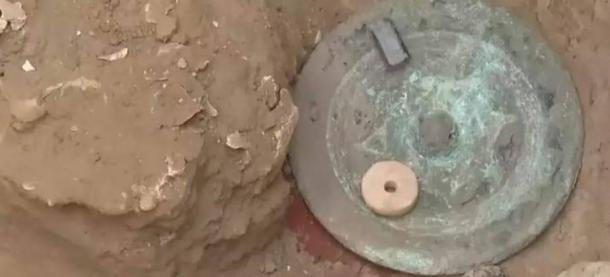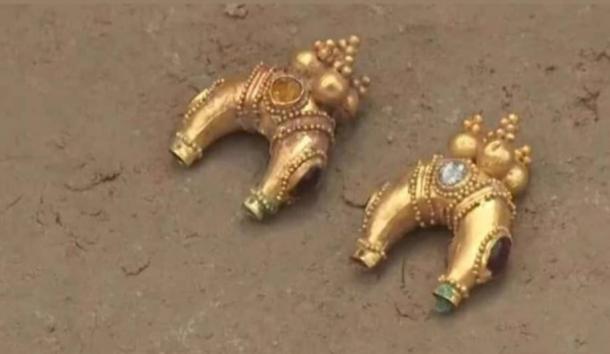Introduction
In the vast expanse of Central Asia, where the ancient Silk Road once thrived, archaeologists have made a remarkable discovery that sheds new light on a little-known yet influential state – the Kangyu. Nestled in the Turkestan region of southern Kazakhstan, the Tolebaitobe cemetery has yielded a treasure trove of artifacts that offer a tantalizing glimpse into the rich history and connections of this once-powerful polity.
The excavation of three burial mounds at the Tolebaitobe site has uncovered a stunning array of relics, including a bronze mirror from the Han dynasty, exquisite polychrome earrings, and other artifacts that point to the Kangyu’s extensive trade and cultural exchanges along the Silk Road. These findings not only enrich our understanding of the Kangyu state but also highlight the interconnectedness of ancient civilizations across the vast Eurasian landmass.
Unearthing the Burial Mounds
The Tolebaitobe cemetery, located in the Karaaspanskogo rural district of the Turkestan region, has proven to be a veritable time capsule, revealing the secrets of the Kangyu people. The excavation of three burial mounds at this site has yielded a remarkable collection of artifacts, including a stunning bronze mirror that dates back to the Han dynasty.
This mirror, found in a woman’s grave, is a testament to the high social status of the deceased. Such mirrors were typically reserved for the wealthy and influential, and their presence in the Tolebaitobe burials underscores the Kangyu’s connections with powerful empires of the time.
Interestingly, similar mirrors have been discovered in other significant archaeological sites, such as Tillya Tepe in Afghanistan and the burial sites of Sarmatian kings in the Southern Urals, as well as in the tombs of the nomadic Xiongnu (Hunnu) from the Shanyu Asian Empire. These parallels highlight the extensive trade and cultural exchange that occurred along the Silk Road during the Kangyu era.

Artifacts from the Kangyu Era
The Kangyu state, which existed from the 2nd century BC to the 4th century AD, was a Central Asian polity located in the Syr Darya basin, encompassing parts of modern-day Kazakhstan, Uzbekistan, and Kyrgyzstan. The Kangyu people were known for their skills in horseback riding and archery, and they engaged in trade and cultural exchanges along the Silk Road, maintaining a semi-nomadic lifestyle while also establishing several fortified cities.
The artifacts uncovered at the Tolebaitobe cemetery provide a wealth of information about the Kangyu culture and its connections with the wider world. In addition to the bronze mirror, the researchers found a jug, a fibula bone used as a pin in the Roman period, earrings, beads, a shoe, a belt buckle, and a bird-hunting arrowhead.
The earrings, in particular, are a stunning example of the Kangyu’s artistic prowess. Crafted in the polychrome style and shaped like the moon, these earrings are inlaid with gold, turquoise, and noble ruby, reflecting the intricate craftsmanship associated with the Sarmatian world and Kangyu culture during the 1st century BC to the 1st century AD.

Connections with Powerful Empires
The artifacts unearthed at Tolebaitobe offer a fascinating glimpse into the Kangyu state’s relations with other major empires of the ancient world. The Kangyu, which included Asiatic Sarmatians, Xiongnu (Hunnu), Kangyu, and later Saki, maintained diplomatic and trade connections with Rome, Byzantium, the Kushan Empire, and China.
This interconnectedness facilitated the exchange of goods, ideas, and culture along the Great Silk Road, contributing to the flourishing of large cities in the region. The bronze mirror, with its intricate design and historical context, serves as a tangible reminder of these extensive trade and cultural networks.
Significance of the Discoveries
The findings at the Tolebaitobe cemetery not only enrich our understanding of the Kangyu state but also highlight the crucial role that Central Asia played in the ancient world’s complex web of relationships. The diverse array of artifacts, including Roman-era fibulae and polychrome earrings, underscores the cultural and economic exchanges that occurred along the Silk Road.
These discoveries provide valuable insights into the social hierarchy, trade practices, and artistic achievements of the Kangyu people. They offer a tangible connection to the broader historical narrative of Central Asia and its influence on the development of ancient civilizations.
As these artifacts find their way into the National Museum, they will continue to inspire and educate future generations about the remarkable history of the Kangyu state and its connections with the great empires of antiquity. The Tolebaitobe excavations have undoubtedly opened a new chapter in our understanding of Central Asia’s rich and multifaceted past.
Conclusion
The unearthing of the Tolebaitobe cemetery in Kazakhstan has revealed a trove of artifacts that shed light on the little-known Kangyu state and its extensive connections with the powerful empires of the ancient world. From the stunning bronze mirror to the exquisite polychrome earrings, these discoveries offer a glimpse into the wealth, artistry, and cultural exchanges that defined the Kangyu’s place along the Silk Road.
As researchers continue to study and preserve these remarkable relics, they will undoubtedly uncover even more insights into the Kangyu’s role in shaping the history of Central Asia. The Tolebaitobe excavations serve as a powerful reminder of the enduring significance of archaeological discoveries in illuminating the past and inspiring us to better understand the interconnectedness of ancient civilizations.

